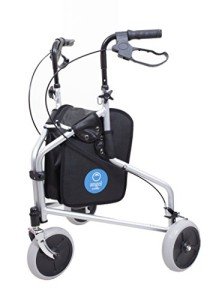16 Facebook Pages That You Must Follow For How To Use A Rollator Marke…
페이지 정보

본문
How To Use A Rollator: A Comprehensive Guide
Rollators are mobility aids designed to improve the self-reliance and safety of people with mobility obstacles. Unlike standard walkers, rollators are equipped with wheels, a seat, and frequently a storage pouch, permitting users to move with higher ease and convenience. This post provides an extensive guide on how to use a rollator successfully and securely, ensuring a smoother and more satisfying walking experience.
What is a Rollator?
A rollator is a wheeled walking aid. It generally has:
- Three or four wheels: Offering stability and maneuverability.
- Hand brakes: For control while walking or when resting.
- A seat: Allowing users to take breaks conveniently.
- Storage space: Such as a basket or pouch for individual items.
Types of Rollators
There are various types of rollators, created to satisfy the needs of various users:
| Type | Description | Best for |
|---|---|---|
| Ultra Lightweight 3 Wheel Rollator With Bag-Wheel Rollator | Lighter and more compact, ideal for indoor use | Browsing tight spaces |
| 4-Wheel Rollator | Offers stability and a bigger seat, ideal for outdoor use | Longer walks and much heavier use |
| Heavy-Duty Rollator | Developed to support more weight with additional robust functions | Users needing extra support |
| Pediatric Rollator | Smaller sized in size, changed for kids | Kids with mobility limitations |
How to Use a Rollator
Utilizing a rollator correctly is crucial to make sure safety and make the most of the benefits it offers. Here's a step-by-step guide:
Step 1: Adjust the Height
Before using the rollator, it is vital to change the handlebars to the correct height.
- Stand directly: With your arms unwinded at your sides.
- Procedure the height: The hand grips need to be at wrist level when the user is standing.
- Safe and secure adjustments: Ensure all locking systems are strongly engaged.
Action 2: Familiarize Yourself with the Rollator
Understanding the components of the rollator will help boost its usability.
- Brakes: Learn how to engage and launch the brakes by squeezing the handles.
- Seat: Identify where to sit easily when you need to rest.
- Storage location: Know where you can keep personal valuables.
Step 3: Start Walking
- Position the rollator: Place it a step ahead of you, guaranteeing that the brakes are launched.
- Grip the manages strongly: Keep a light stress in your arms while keeping the rollator.
- Step inside the frame: Move forward by stepping with one foot and after that the other.
- Keep a straight posture: Walking ought to be upright, preventing the temptation to lean on the rollator excessively.
Step 4: Utilize Brakes
Always use the brakes successfully to improve safety:
- To decrease: Gradually squeeze the brakes.
- To stop: Fully engage the brakes by pulling on both handles.
- To sit down: Ensure the rollator is stable, then carefully lower yourself onto the seat.
Step 5: Maneuver with Care
Turning and navigating can be tough, so here are essential ideas:
- Telegraph your direction: Look where you want to go before turning.
- Take small actions: Move gently when turning to keep balance.
- Use a three-point turn: Turn from one side to the other, keeping the walker close.
Step 6: Practice Stopping and Resting
Taking breaks is vital. Here are tips for resting:
- Find flat surfaces: Ensure the location is level when you sit.
- Engage the brakes when seated: This will prevent rolling.
- Shift position gradually: When ready to stand again, get rid of the brakes before rising.
Upkeep and Safety Tips
To ensure the rollator stays functional and safe:
- Regularly check the brakes: Ensure they engage and release correctly.
- Inspect wheel alignment: Wheels needs to not wobble; tighten any loose screws.
- Clean the rollator: Wipe down surfaces and eliminate debris from tires to keep smooth operation.
Common Concerns
Users might face a number of typical issues when utilizing rollators. Here are some general FAQs:
FAQs
Q1: Can I use a rollator outdoors?A: Yes, a lot of
rollators are developed for both indoor and outdoor use. However, guarantee it has the appropriate wheel size and tread for outdoor surfaces. Q2: What are the weight limits on rollators?A: Weight limits
typically vary by model, however durable rollators can generally accommodate users weighing around 300 to 500 pounds. Q3: Are rollators adjustable?A: Yes, most rollators come with adjustable manage heights to accommodate users of numerous heights

. Q4: How do I transfer a rollator?A: Many rollators canbe folded for hassle-free transportation in a lorry. Constantly check the user manual for specific folding guidelines. Q5: Can I use a rollator while recuperating from surgery?A: Yes, lots of individuals use rollators during healing to regain strength and balance, however guarantee you follow your doctor's suggestions.
Comprehending how to use a rollator correctly can significantly improve mobility and decrease the danger of falls. Whether you are brand-new to using mobility aids or aiming to refine your method, following the standards talked about in this short article is vital. With practice, a rollator can improve independence while ensuring safety, hence enabling users to take pleasure in a more active way of life.
- 이전글안양 비아몰 qldkahf 25.06.13
- 다음글Gaming_Establishments: A Core of Recreation and Risk 25.06.13
댓글목록
등록된 댓글이 없습니다.
